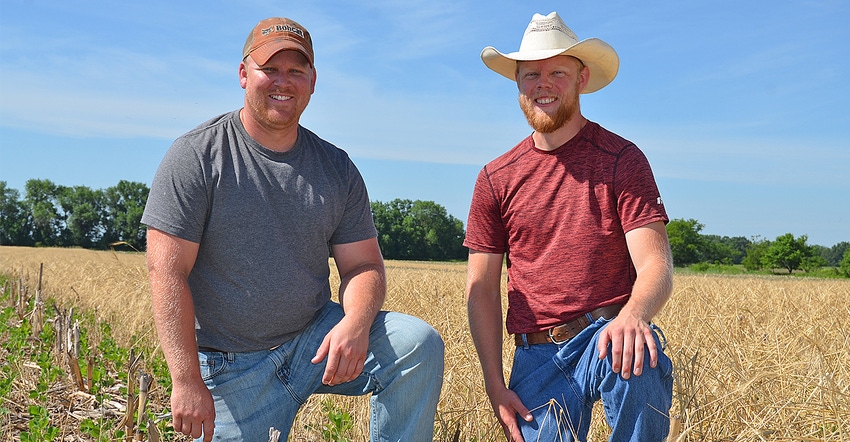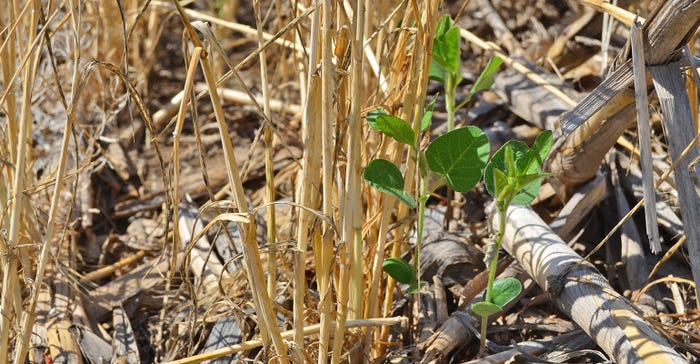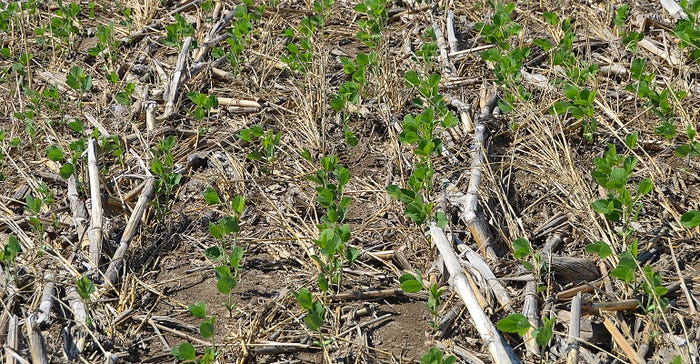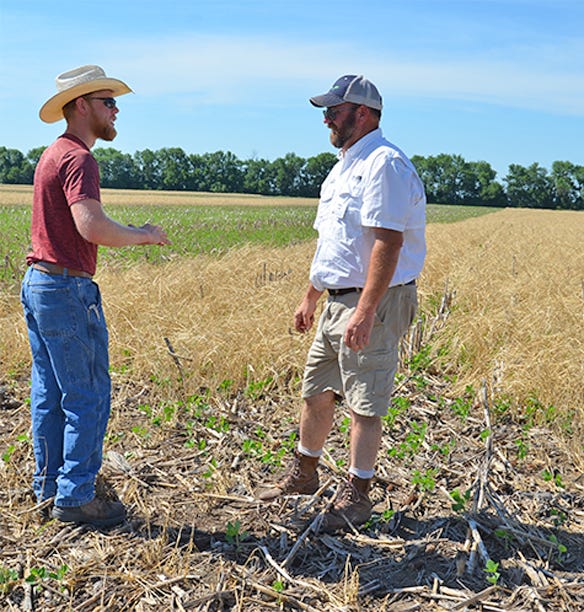
There is still much to learn about cover crops. For the Brinker brothers near Auxvasse, Mo., the question is, can you balance sustainability with profitability?
Cody and Travis Brinker have been planting cover crops for the past two years. “We are just getting started,” Cody says. The brothers plant all their soybean fields and cornfields into established cereal rye.
“We figured if we are doing cover crops, it might be smart to know what we are doing,” Travis adds.
So, this year, the brothers are taking part in the University of Missouri Certified Strip Trial Program cover crop trials. “This experiment looks at the point you terminate a cover crop to make way for the commodity crop,” Rusty Lee, MU Extension agronomist, says. “We’ve always been asked questions on termination timing; now, with the cover crop trials, we are trying to find some of those answers.”

FINDING COVER: A young soybean plant finds a little shade beneath a stand of rye. The later-terminated cover crop keeps both the plant and soil cooler.

Creating cover
After the 2017 corn harvest, the Brinkers drilled 40 pounds to the acre of cereal rye into the crop residue. Then the brothers just watched the rye grow for the next six months.
On May 8, the brothers set out with a 90-foot sprayer to chemically terminate swaths of rye cover crop. They turned off the sprayer for 90 feet and then turned it back on, leaving strips of rye still growing.
“With the sprayer technology of today, it makes it simple to lay out these types of plots,” Lee says. “Farmers can do this type of research on their own farm.”
Since the weather pushed back soybean planting, the brothers drilled beans in on May 17 into both the terminated and non-terminated, or “green,” cover. On May 24 they terminated the remaining tall rye strips.
By early June, the fields showed a distinct change.
“There was 17 days’ difference in termination dates,” Lee says, pointing to the brown rye still standing. “The later termination had more height and biomass than the earlier-terminated rye cover.”
Using cover crops in a farm management plan is all about keeping green material on the land more months of the year. “We are trying to keep living roots in the soil longer,” he says. The added biomass is promoting soil health and plant growth.

BARE BEANS: Soybean plants are still growing strong despite an early termination of the rye cover crop.

Seeing soil benefits
The Brinkers find cover crops keep soil temperatures cooler and retain moisture for the soybean plants.
“This rye cover and crop residue stops sunlight from hitting directly on the soil,” Cody explains. The brothers conduct their own on-site analysis where they place a soil thermometer into both areas with cover crops and those with bare ground. In the summer months, they find the bare ground 10 degrees F warmer than the soil under some cover. Cooler temperatures and cover allow young plants to flourish.
Moisture also stays in place. Cody explains how residue keeps rain from hitting the bare ground and breaking up the soil. Instead, rain penetrates down into the soil and travels along the biomass root system.
According to Travis, there is more going on underground than above ground in a cover crop system. “The roots are breaking up the soil, providing a way for the water to get into the soil profile to be taken up by the growing soybean plants.”
Still, leaving the cover crop on too long can wreak havoc on a combine during harvest. So, just how long should cover crops be left on a field for grain crops to realize the benefits? And will time impact productivity?

PUBLIC-PRIVATE PARTNERSHIP: Cody Brinker (left) visits with MU Extension agronomist Rusty Lee about the cover crop strip trial on their farm near Auxvasse, Mo. The Brinker family provides the land for the on-farm trials put on by the university.

Waiting on results
This MU Extension cover crop trial is being replicated across the state in 2018. Yield results are expected after harvest.
“There is a lot that we don’t know about soil health and biology in soil and roots, but we’ve learned quite a bit about beneficial changes in soil health as we add cover crops,” Lee says. “This experiment helps fine-tune our management of cover crops.”
Whatever the outcome, the Brinkers remain committed to cover crops. They continue to terminate rye before planting corn. However, this strip trial will allow them to determine the best timing for killing rye before planting soybeans, and possibly boost yield and profitability.
Investing in sustainability practices has a cost. It requires investment in seed, equipment and labor to plant. Then more money is needed for chemicals, equipment and labor to terminate.
But for the Brinker brothers, it is more than just dollars and cents.
“Some claim they can grow better crops by working the dirt up,” Travis says. “But if all your dirt is going to be gone, there is nothing left for the next generation — it is not very sustainable.”
About the Author(s)
You May Also Like






